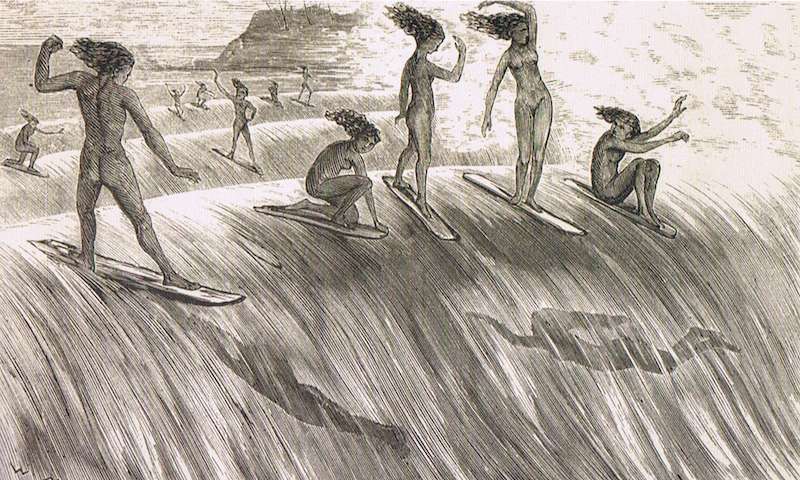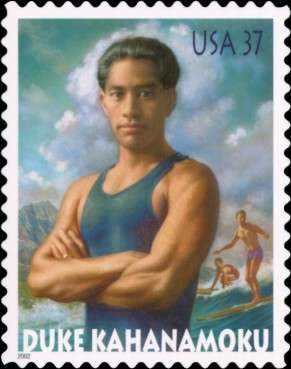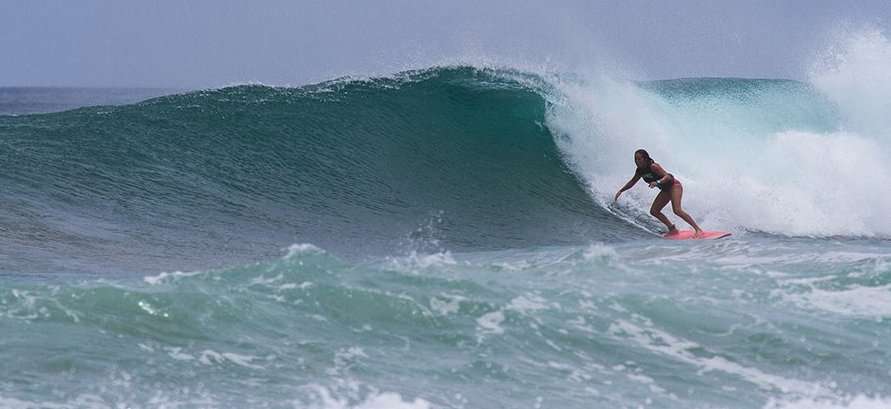
The art of surfing, called he’enalu in the Hawaiian language was first observed by Europeans in 1767, by the crew members of the Dolphin at Tahiti. Surfing was a central part of ancient Polynesian culture. The chief was the most skilled wave rider in the community with the best board made from the best tree. The ruling class had the best beaches and best boards, and the commoners were not allowed on the same beaches, but they could gain prestige by their ability to ride the surf on their extremely heavy boards. When the missionaries from Scotland and Germany arrived in 1821, they forbade or discouraged many Polynesian traditions and cultural practices, including, on Hawaii, leisure sports such as surfing. By the 20th century, surfing, along with other traditional practices, had all but disappeared. Only a small number of Hawaiians continued to practice the sport and the art of crafting boards.
Ancient Hawaii
The Ancient Hawaiian people integrated surfing into their culture and made surfing more of an art than anything else. They referred to this art as he’e nalu, which translates into English as “wave sliding.” The art began before entering the mysterious ocean as the Hawaiians prayed to the gods for protection and strength to undertake the powerful mystifying ocean. If the ocean were tamed, frustrated surfers would call upon the Kahuna (priest), who would help them in a surfing prayer asking the gods to deliver great surf. Prior to entering the ocean, the priest would also help the surfers (mainly of the upper class) in undertaking the spiritual ceremony of constructing a surfboard. Hawaiians would carefully select one of three types of trees.
North America
In 1907 George Freeth was brought to California, to demonstrate surfboard riding as a publicity stunt to promote the opening of Los Angeles- Redondo-Huntington railroad owned by Henry Huntington, who gave his name to Huntington Beach. After that he traveled up and down the coast demonstrating surfing and lifeguarding skills. Surfing on the East Coast of the United Sates began in Virginia Beach in 1912 with James Matthias Jordan, Jr., who impressed locals with surfing a board his uncle gave him. After that it came to Australia. Around the beginning of the 20th  century, Hawaiians living close to Waikiki began to revive surfing, and soon re-established surfing as a sport. Duke Kahanamoku, “Ambassador of Aloha,” Olympic medalist, helped expose surfing to the world. Surfing progressed tremendously in the 20th century, through innovations in board design and ever increasing public exposure. Surfing development and culture was centered primarily in three locations: Hawaii, Australia, and California. Until the 1960’s, it had only a small following even in those areas. The release of the film Gidget (first book) boosted the sport’s popularity immensely, moving surfing from an underground culture into a national fad and packing many surf breaks with sudden and previously unheard of crowds. B-movies and surf music such as the Beach Boys and Surfaris based on surfing and Southern California beach culture (Beach Party films) as it exploded, formed most of the world’s first ideas of surfing and surfers. Regardless of its usually erroneous portrayal in the media, true surfing culture continued to evolve quietly by itself, changing decade by decade. From the 1960s fad years to the creation and evolution of the short board in the late 60’s and early 70s to the performance hot-dogging of the neon-drenched 1980s and the epic professional surfing of the 1990s (typified by Kelly Slater, the “Michael Jordan of Surfing”). Surfing documentaries have been one of the main ways in which surfing culture grows and replenishes itself, not just as a sport but as an art form, the style and quality of surf films have often tracked well the evolution of the sport.
century, Hawaiians living close to Waikiki began to revive surfing, and soon re-established surfing as a sport. Duke Kahanamoku, “Ambassador of Aloha,” Olympic medalist, helped expose surfing to the world. Surfing progressed tremendously in the 20th century, through innovations in board design and ever increasing public exposure. Surfing development and culture was centered primarily in three locations: Hawaii, Australia, and California. Until the 1960’s, it had only a small following even in those areas. The release of the film Gidget (first book) boosted the sport’s popularity immensely, moving surfing from an underground culture into a national fad and packing many surf breaks with sudden and previously unheard of crowds. B-movies and surf music such as the Beach Boys and Surfaris based on surfing and Southern California beach culture (Beach Party films) as it exploded, formed most of the world’s first ideas of surfing and surfers. Regardless of its usually erroneous portrayal in the media, true surfing culture continued to evolve quietly by itself, changing decade by decade. From the 1960s fad years to the creation and evolution of the short board in the late 60’s and early 70s to the performance hot-dogging of the neon-drenched 1980s and the epic professional surfing of the 1990s (typified by Kelly Slater, the “Michael Jordan of Surfing”). Surfing documentaries have been one of the main ways in which surfing culture grows and replenishes itself, not just as a sport but as an art form, the style and quality of surf films have often tracked well the evolution of the sport.

Nicaragua
Surfing is relatively very new in Nicaragua, with the oldest generation of surfers having been born in the late 70’s and early 80’s and not taking up surfing until the late 90’s. Female surfing in Nicaragua is even newer. Upon Ashley’s arrival in 2003, there we no Nicaraguan women surfing at all and there is still only a handful of Nicaraguan women who have taken up the sport to date. Elsi Marin, our Lead Surf Instructor, is one of those women and is one of the first of her kind. We are uniquely positioned at Chica Brava to have a profoundly positive impact of the young women of Nicaragua, showing them how healthy living, success, and empowerment can all be achieved through surfing.



